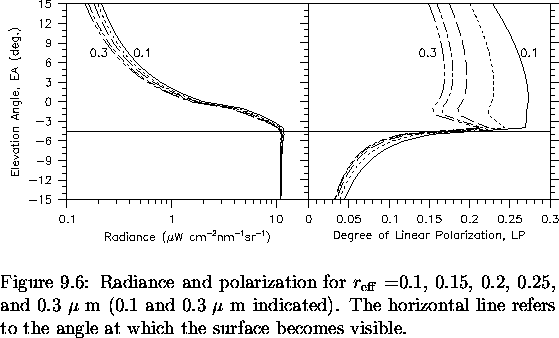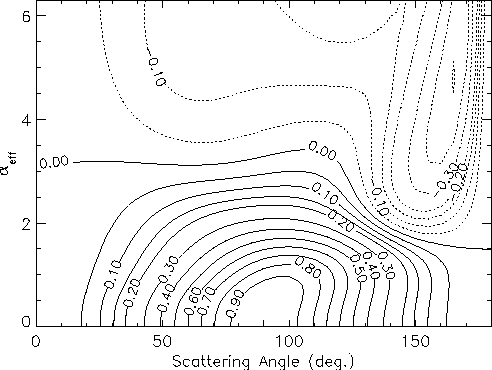
 |
The effect of varying the value of
![]() is now examined.
Model calculations were performed for values of 0.1 to 0.3
is now examined.
Model calculations were performed for values of 0.1 to 0.3 ![]() m in
0.05
m in
0.05 ![]() m increments while holding
m increments while holding
![]() constant at 0.17.
Results are shown in Figure 5.7 at 750 nm.
The radiances were largely insensitive to
constant at 0.17.
Results are shown in Figure 5.7 at 750 nm.
The radiances were largely insensitive to
![]() with a maximum difference of 5% between
with a maximum difference of 5% between
![]() m
and 0.10
m
and 0.10 ![]() m. In general, differences between neighbouring
curves were at the 3% level or smaller.
The main reason for this is that until the
particles are small enough that they begin to behave as Rayleigh scatterers,
the phase function varies slowly with size
except in the forward and, to a lesser extent, the
backward scattering directions. The transition to Rayleigh
scattering at 750 nm occurs near
m. In general, differences between neighbouring
curves were at the 3% level or smaller.
The main reason for this is that until the
particles are small enough that they begin to behave as Rayleigh scatterers,
the phase function varies slowly with size
except in the forward and, to a lesser extent, the
backward scattering directions. The transition to Rayleigh
scattering at 750 nm occurs near
![]() m.
Comparing the 0.10
m.
Comparing the 0.10 ![]() m and 0.30
m and 0.30 ![]() m radiances, the largest
difference is about 30% which occurs at EA
m radiances, the largest
difference is about 30% which occurs at EA
![]() .
Differences decrease to approximately 20% near EA=0.
Polarization is observed to be much more sensitive. Between 0.1 and
0.15
.
Differences decrease to approximately 20% near EA=0.
Polarization is observed to be much more sensitive. Between 0.1 and
0.15 ![]() m, there is a maximum difference of 0.05 near
m, there is a maximum difference of 0.05 near
![]() .
For larger aerosols, this difference decreases to less than 0.02.
In addition, the shape of the polarization curve is observed
to vary. For small aerosols,
the characteristic increase near
.
For larger aerosols, this difference decreases to less than 0.02.
In addition, the shape of the polarization curve is observed
to vary. For small aerosols,
the characteristic increase near
![]() is absent
at 0.10
is absent
at 0.10 ![]() m while it is larger for 0.30
m while it is larger for 0.30 ![]() m.
m.
As the effects of single-scattering should be evident at 750 nm, it
is worthwhile to examine the single-scattering polarization,
-P21/P11 (assuming initially unpolarized light).
As a function of the effective size parameter,
![]() ,
and scattering angle, the
-P21/P11 ratio is shown in Figure 5.8
assuming initially unpolarized light.
For scattering angles between 70-110
,
and scattering angle, the
-P21/P11 ratio is shown in Figure 5.8
assuming initially unpolarized light.
For scattering angles between 70-110![]() and
and
![]() between 0.75-3.0, the polarization changes
very rapidly. This is the region where Rayleigh scattering
is approached. For scattering angles near the forward and backward
directions, the variation in polarization is much smaller.
In fact, theory states that the polarization state is identically zero
(for spherical particles) in the forward and backward directions,
irrespective of the size of the scatterer.
At 750 nm, the range over which
between 0.75-3.0, the polarization changes
very rapidly. This is the region where Rayleigh scattering
is approached. For scattering angles near the forward and backward
directions, the variation in polarization is much smaller.
In fact, theory states that the polarization state is identically zero
(for spherical particles) in the forward and backward directions,
irrespective of the size of the scatterer.
At 750 nm, the range over which
![]() is
sensitive is 0.1-0.25
is
sensitive is 0.1-0.25 ![]() m, the same range that was observed in
Figure 5.7. It is also evident that beyond 0.35
m, the same range that was observed in
Figure 5.7. It is also evident that beyond 0.35 ![]() m
(or
m
(or
![]() ), polarization changed very slowly.
Shifting the size range over which the polarization is
sensitive towards larger particles, as has been observed following
a large volcanic eruption, would necessitate accessing longer
wavelengths which are not measured by the CPFM instrument.
The steep valley of negative polarization, located at 165
), polarization changed very slowly.
Shifting the size range over which the polarization is
sensitive towards larger particles, as has been observed following
a large volcanic eruption, would necessitate accessing longer
wavelengths which are not measured by the CPFM instrument.
The steep valley of negative polarization, located at 165![]() ,
is also quite sensitive to
,
is also quite sensitive to
![]() between 1.5 and 3.5.
This feature is a glory effect, the result of light
impinging on the particle at near grazing incidence which sets up
surface waves on the particle and acts to focus light in the near-forward and
near-backward directions (van de Hulst, 1957). This hill becomes
much steeper for smaller values of variance; reducing
between 1.5 and 3.5.
This feature is a glory effect, the result of light
impinging on the particle at near grazing incidence which sets up
surface waves on the particle and acts to focus light in the near-forward and
near-backward directions (van de Hulst, 1957). This hill becomes
much steeper for smaller values of variance; reducing
![]() to 0.07 would lead to a minimum in polarization of approximately 0.65.
This feature would be ideal for the retrieval of aerosols between
to 0.07 would lead to a minimum in polarization of approximately 0.65.
This feature would be ideal for the retrieval of aerosols between
![]() and
and ![]() m. Unfortunately, this geometry
requires a solar zenith angle of at least 65
m. Unfortunately, this geometry
requires a solar zenith angle of at least 65![]() .
.
Based on the discussion above, two other geometries have been
investigated. The first,
![]() and
and
![]() ,
results in scattering angles near the
forward direction. The second,
,
results in scattering angles near the
forward direction. The second,
![]() and
and
![]() ,
gives scattering angles through the
glory, as discussed above.
A summary of the polarization results are given
in Table 5.3 in terms of the difference in polarization
for uplooking angles between consecutive values of
,
gives scattering angles through the
glory, as discussed above.
A summary of the polarization results are given
in Table 5.3 in terms of the difference in polarization
for uplooking angles between consecutive values of
![]() studied. For near-forward scattering angles, the difference in
polarization was minimal and very close to zero. Scattering angles
through the glory resulted in rapidly varying polarization,
even for larger aerosol sizes. The difference between these geometries
is striking. These single-scattering polarization maps can be
quite useful in determining which geometries
are best suited to retrievals and, perhaps, may even be used
in a rough estimate of the effective variance.
studied. For near-forward scattering angles, the difference in
polarization was minimal and very close to zero. Scattering angles
through the glory resulted in rapidly varying polarization,
even for larger aerosol sizes. The difference between these geometries
is striking. These single-scattering polarization maps can be
quite useful in determining which geometries
are best suited to retrievals and, perhaps, may even be used
in a rough estimate of the effective variance.